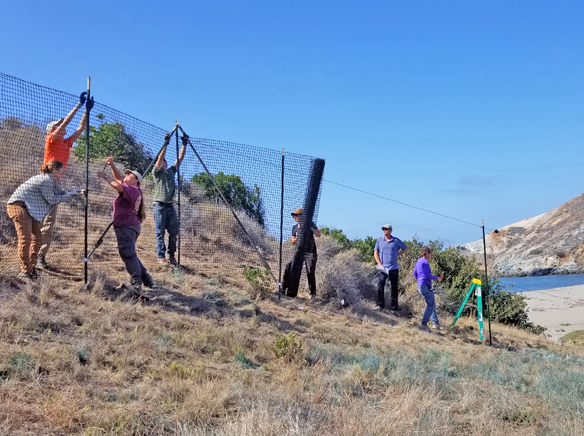
A new exclosure in Little Harbor showcases the unique habitat type while focusing on two rare species
Catalina’s long history of introduced herbivores such as mule deer has significantly impacted the Island’s ecology and biodiversity. The Catalina Island Conservancy conservation team’s relentless work provides glimpses into Catalina as it once was.
In early December, the Conservancy completed a 1,775 square foot restoration project at Little Harbor. The project highlights several unique and rare Coastal Sage Scrub species and conserves two rare species that may be lost if restoration work is not completed. Malva rosa (Malva assurgentiflora ssp. glabra) and cliff spurge (Euphorbia misera) each only exist in a couple of populations on Catalina.
“Recent surveys have indicated that about 70 percent of the cliff spurge on the Island has been extirpated from our landscape, and malva rosa is only found here naturally on two small islets off the Catalina coastline,” said Conservancy Conservation Horticulturist Cayman Lanzone. “Our goal with this demonstration garden is to showcase these two rare species in a specially-designed exclosure, not only so the public can see and appreciate them, but also to increase the unique flora’s population.”
The Conservancy installed a dripline watering system that targets individual plants, reducing water usage in maintaining plant health and requires less time and maintenance than previous plantings. This will provide insight into whether the concept can be upscaled to larger restoration projects.
In addition to cliff spurge and malva rosa, giant coreopsis (Leptosyne gigantea), summer holly (Comarostaphylis diversifolia ssp. planifolia), Dudleya species including D. virens ssp. hassei and D. virens ssp. insularis, Bladderpod (Peritoma arborea), chaparral bush mallow (Malacothamnus fasciculatus var. catalinensis) and white sage (Salvia apiana) also grace the restoration site.
“With this exclosure, we are trying to replicate what coastal sage scrub habitat in Little Harbor may have looked like a couple centuries ago and provide an educational opportunity for the public while doing so,” added Lanzone. “Ultimately, work on preserving these important species will help protect them.”
In the future, the Conservancy plans to add descriptive signage highlighting the unique flora in the future. In the meantime, the demonstration garden is available for your viewing pleasure!
For more information on Catalina Island restoration, visit catalinaconservancy.org.









